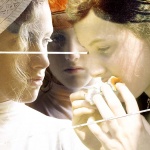.............L’imagerie della pittrice interseca così le strade della parola senza ossequio ma con rispetto, e di contro la parola dei poeti (e che poeti di gran nome!) si insinua sotto il velo elettronico con circospezione amicale. Il connubio tra le due espressioni si perfeziona proprio nel momento in cui testi ed immagini si possono leggere insieme sciogliendo nessi non facili (aggressivi possono essere i quadri della pittrice quanto taglienti i versi) o riallineando storie reciproche (mai piane per quanto possano apparire) o intrecciando memoria (non affatto in margine) a sensitiva presenza (ammantata di silenziosa ma turbata bellezza). Certo, l’operazione della pittrice digitale - che pur ben conosce la pregnanza della ‘vanitas’ nel dipinti antichi - appartiene alla contemporaneità del mostrare mentre la parola scritta (salvo eccezioni) sembra oggi arrancare alla ricerca di nuovi spazi perché - dopo decenni di tagli alla pubblica istruzione e di disinvestimenti nella cultura (anche qui fatte salve le eccezioni) ci siamo fondalmentalmente disabituati a leggere e tanto più ad ascoltare attentamente. Ma se, alla fine, le poche immagini che salviamo sono quelle che più ci han perseguitato, così le parole più vere e inobliabili saranno quelle che - nel bene e nel male - hanno inciso sanguinosamente in profondità la nostra carne. Alberto Crespi
Il sangue amaro | Nuovi ArgomentiNuovi Argomenti |
….........The imagery of the painter intersects the streets of the word with no deference, yet with respect, and in contrast with the poets' word (and how big are their names!), it creeps under the electronic veil with friendly circumspection. The combination of the two expressions improves at the very moment when texts and images can be read together, dissolving not easy connections ( the artist's paintings can be aggressive and the verses sharp) or realigning each other's stories (never flat as they may appear) or weaving memory (not at all on the margin) to sensitive presence (enveloped by silent but troubled beauty) . Of course, the operation of the digital painter - who knows well the significance of the ' vanitas ' in ancient paintings - belongs to the contemporaneity of showing, while the written word (with some exceptions) seems to today plod along the search for new spaces because - after decades of cuts in public education and divestitures in the culture (again, subject to the exceptions), we have fundamentally lost the habit of reading, and even more of listening carefully. Yet, if, in the end, the few images we save are those which persecuted us the most, so the truer and unforgettable words will be those which - for better or worse - have violently and deeply affected our flesh. Alberto Crespi |
 Italiano
Italiano English
English
















